 |
| The World War
period |
Canada and World War
I
The new Conservative government, headed by Robert Laird Borden,
had the responsibility of rallying the nation to Britain's side
in World War I. Had Canadians remained as divided as they were
at the end of Laurier's term, this might have been a difficult
thing to do. But Germany's invasion of neutral Belgium in 1914
forged a unity of Canadian sentiment and a demand for participation
in the conflict.
The first Canadian contingent, numbering 33,000, reached England
soon after the outbreak of war in 1914, and it was in the thick
of the fighting on the continent a few months later in the second
battle of Ypres. By 1916 the Canadians had formed four divisions,
with a fifth to provide reinforcements. The four divisions of
the Canada Corps earned an outstanding reputation as a fighting
force.
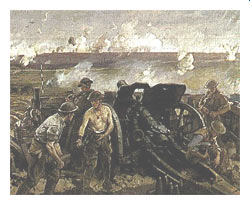
Canadian soldiers near
Vimy, France |
More significant, however, was the fact that Canada was playing
a respectable role on the world stage, a role that would soon
help undo its colonial status. Before the war ended in 1918,
more than 619,000 officers and men had enlisted, including some
22,000 who had served in the British Royal Air Force. More than
60,000 Canadians were killed in action or died of wounds, a
terribly heavy toll in relation to the country's population.
Over 66 million shells were produced in Canadian factories.
The gross national debt soared from 544 million dollars in 1914
to almost 2 1/2 billion dollars in 1919, most of the money being
raised in Canada itself through public war loans.
The Canadian forces at the outset were made up wholly of volunteers.
Casualties and the rapidly accelerating pace of the war made
the bitter question of conscription a major issue by 1917. Borden
met it by forming a coalition government of Conservatives and
Liberals, though Laurier refused to join the coalition. In the
election of that year, Quebec was almost unanimous in its opposition
to the conscription policy that was supported elsewhere across
the country. The political solidarity of the province during
the next 25 years was largely derived from its memory of that
episode.
On the battlefronts in France and Belgium, Canadians of both
nationality backgrounds made magnificent contributions to the
final victory. They faced with heroism the first poison-gas
attack in the history of warfare during the second battle of
Ypres in 1915. Other engagements in which Canadian forces earned
the admiration of all the Allies included the battles of Mount
Sorrel (1916), the Somme (1916), and Vimy Ridge (1917). The
victory of Passchendaele Ridge in the autumn of 1917 alone cost
16,000 Canadian casualties. In 1918 during the closing months
of the war, Canadians again saw heavy action at Amiens, Cambrai,
and Mons.
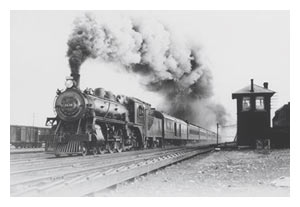 Canada
Between the Wars Canada
Between the Wars
At the end of 1919 the Canadian government acquired the Grand
Trunk Pacific Railway and the Canadian Northern Grand Trunk
and merged them to create the publicly owned Canadian National
Railways.
Upon Borden's retirement in 1920, Arthur Meighen succeeded as
prime minister. The election of 1921 brought the Liberals back
into office under a new leader, William Lyon Mackenzie King
(see King, Mackenzie). Because the government had a bare majority,
it depended upon the support of the Progressive (Farmer) party
members. After four years of timid Liberal leadership, a new
election strengthened the Conservative representation but not
quite to the point of giving the party control of Parliament.
This was accomplished in 1926, when a scandal in the Department
of Customs and Excise cost the Liberals their majority in the
House. By political shrewdness, however, King forced Meighen's
second government to go to the people for an election within
a matter of days; and the Liberals were once more returned to
power.
The 1920s were marked everywhere by a spiraling expansion of
business. Technical and industrial advances paced the rising
standard of living. In the summer of 1929 industrial production
began to slow significantly. In October of that year the stock
market crash heralded unemployment and financial ruin across
Canada, as it did elsewhere in the world.
Defeated in the 1930 elections, King made way for the Conservatives
under Richard Bedford Bennett (later Viscount Bennett). Bennett
thus had the unenviable responsibility of dealing with the Great
Depression. His inability to deal with the crisis, coupled with
the severe drought in the prairies, led Canadians to desert
the Conservatives. The election of 1935 brought the Liberals
back into office, a position they were to continue to hold without
interruption for 22 years.
The British Commonwealth
of Nations
The period between the wars brought the culmination of Canada's
growth to independent nationhood within the British Commonwealth.
Prime Minister Borden had been included in the Imperial War
Cabinet in London. He piloted through the Imperial Conference
of 1917 a resolution that the dominions "should be recognized
as autonomous nations of an imperial commonwealth." To both
the 1919 Peace Conference and the League of Nations Canada sent
its own delegates.
The Imperial Conference of 1926 confirmed in its Declaration
of Equality that the United Kingdom as well as the dominions
had become "autonomous Communities within the British Empire,
equal in status, in no way subordinate one to another." They
were, however, "united by a common allegiance to the Crown,
and freely associated as members of the British Commonwealth
of Nations." These resolutions were confirmed by the British
Parliament in 1931 in the Statute of Westminster. The statute
provided that no law passed in the future by the United Kingdom
should extend to any dominion "except at the request and with
the consent of that Dominion."
Canadian sovereignty thus had been achieved by a long process
of peaceful constitutional evolution. This was vividly demonstrated
by the independent decision of its Parliament that Canada enter
World War II at the side of Britain, which it did within a week
of the outbreak of hostilities in September 1939.
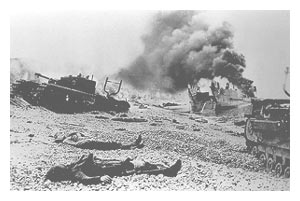
Canadian casualties near
Dieppe, France |
Canada and World War
II
Within three months an entire division of the new Canadian Active
Service Force had been transported to the United Kingdom, and
an agreement had been announced for a British Commonwealth Air
Training Plan to be centered in Canada. This project alone trained
more than 131,000 aircrew personnel for the Commonwealth. Canada
contributed 72,800 pilots, navigators, aerial gunners and bombardiers,
and flight engineers. These Canadians saw service in almost
every theater of war.
The Royal Canadian Navy was increased from fewer than a dozen
vessels to more than 400. It served primarily as an antisubmarine
and convoy force in the North Atlantic. Some of its units were
deployed from time to time as far away as the Mediterranean
and the Pacific. The forces under the command of Gen. A.G.L.
McNaughton were required to spend a long and frustrating period
on vital guard duty in Britain throughout the period of greatest
threat of German invasion. Elsewhere abroad, two Canadian battalions
sent to Hong Kong in 1941 were overrun when the colony was captured
by the Japanese at the end of that year.
The first engagement of the enemy by Canadian forces based in
England occurred in 1942 in a courageous, but terribly costly,
commando-type raid against Dieppe. In the summer of 1943 Canadian
troops were sent into action with the British in the successful
assault against Sicily, whence they carried the campaign to
the Italian mainland. Early in 1945 the Canadians were withdrawn
from Italy to permit reunification of the Canadian Army in northwestern
Europe.
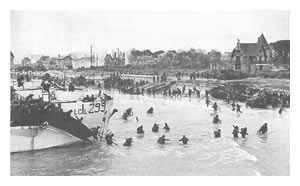
D-Day |
The climax of the war had already come, however, with the Normandy
landings in June 1944, in which the Canadian Army played an
important part. Instrumental in the capture of Caen, which followed,
the Canadians won another major victory in the closing of the
Falaise gap later the same summer. In the costly and difficult
battle of the Scheldt estuary that autumn, the Canadians cleared
the sea passage to Antwerp, already in Allied hands. In the
bitter battle along the Hochwald Ridge in February 1945, Canadian
losses were extremely heavy. This battle opened the final attack
across the Rhine, which was a prelude to the unconditional surrender
by Germany on May 7, 1945.
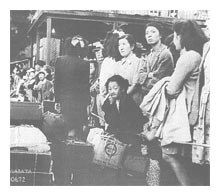
1943. Canadian citizens
of Japanese ancestry in internment camps, a shameful time
in our history |
All persons over 16 years of age were required to take part
in a national registration for war service, and compulsory military
service for home defense only was introduced. Prime Minister
King had assured the nation that there would be no conscription
for overseas duty. As the war wore on, however, it became increasingly
clear that the government needed to be released from the commitment.
King accomplished this by a national plebiscite. All the provinces
except Quebec voted in favor of conscription for overseas service
if necessary. In 1944, after the Normandy invasion, the drain
on manpower became so severe that draftees were sent overseas
for the first time as reinforcements for the troops in Europe.
The losses in the war overseas were complemented by economic
gains on the homefront. War productivity effectively ended the
Great Depression and greatly increased the labor force. Canadian
workers produced raw materials, farm products, and manufactured
goods needed to fight the war; and this was all done in a volume
unprecedented in Canadian history. Industrialization was thus
rapidly advanced, through both investment of capital and striking
advances in technology.
|
|